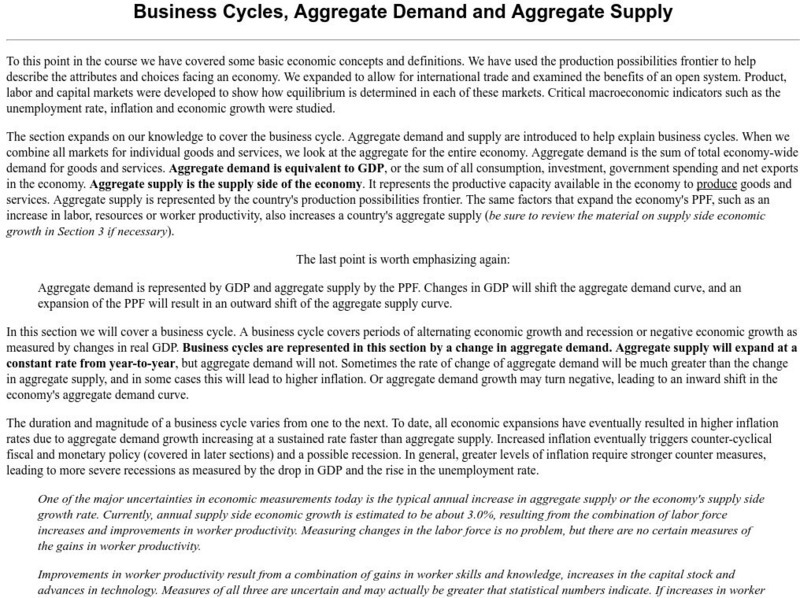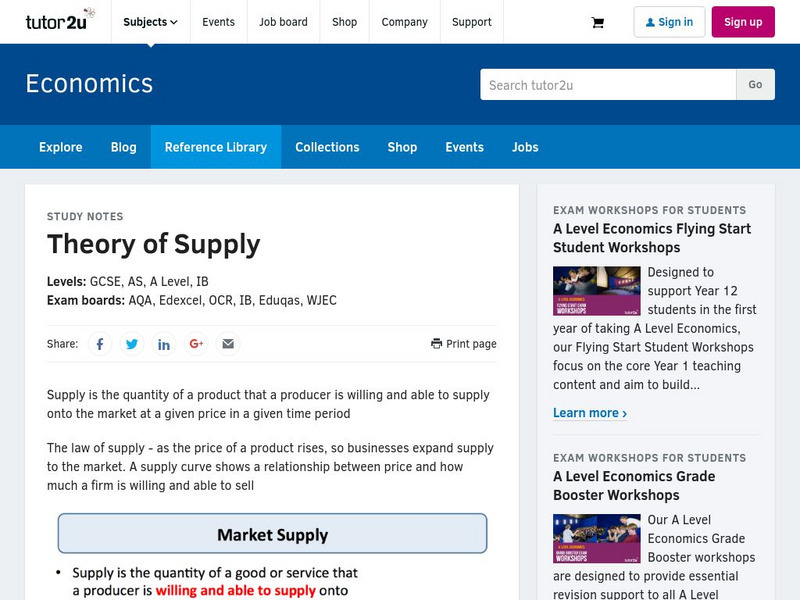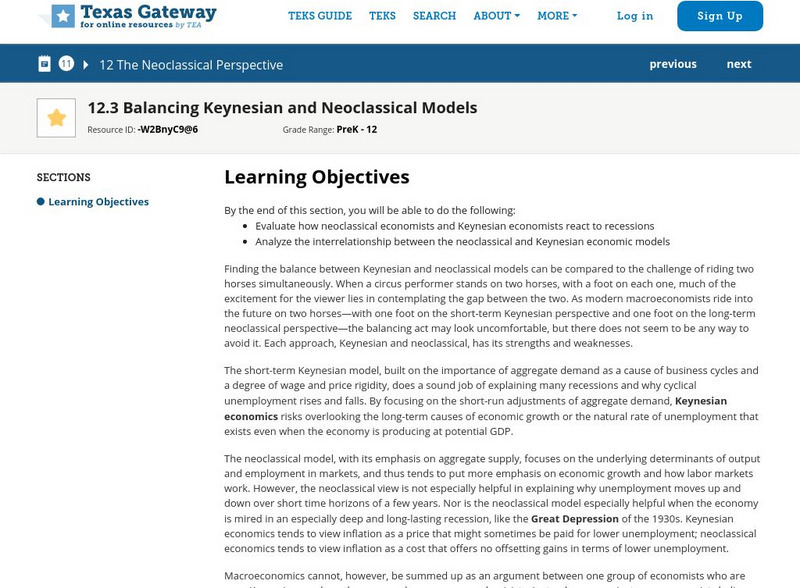Hi, what do you want to do?
University of Nebraska Omaha
Ec Ed Web: Andersonville Prison: An Economic Microcosm
This site provides a lesson plan that investigates concepts of scarcity, economic wants, command economic systems, market economic systems, and markets and prices.
Scholastic
Scholastic: Serving Up Economics
This lesson plan describes how students can use a restaurant setting to study the basic concepts of economics, while they learn business, math, and even get to eat.
University of Colorado
University of Colorado: Aggregate Supply and Demand
This site is a short lesson on business cycles, aggregate demand, and aggregate supply. It has some good explanations of the terms.
Other
Classroom Clues: Children's Literature for Understanding Economics
How do you teach obscure economic concepts to younger elementary students? One way is through children's literature. This site has a large variety of children's picture books that teach various economic concepts such as supply and...
University of Nebraska Omaha
Ec Ed Web: Analyzing the Demand Curve
Lists the determinants of demand for a product and service. The site is useful for students wishing to look further into the causes of demands. Graphs and summaries are included to aid research.
Khan Academy
Khan Academy: Determinants of Price Elasticity and the Total Revenue Rule
Practice what you've learned about the relationship between price elasticity of demand and total revenue in this exercise. This resource is designed as a review for the AP Microeconomics Test or a college-level microeconomics course.
Robert Schenk, PhD
Cyber Economics
An incredible site! This is an interactive textbook that clearly and concisely covers any topic you can think of under both microeconomics and macroeconomics. Select "Table of Contents" to begin.
Khan Academy
Khan Academy: Shifts in Aggregate Supply
If either the aggregate supply or aggregate demand curve shifts in the aggregate demand/aggregate supply-AD/A-model, the original equilibrium in the AD/AS diagram will shift to a new equilibrium. Increases and decreased in the price of...
Curated OER
Market Price: Supply & Demand
This site from Wood Green School Witney explains market price. It includes graphs related to supply and demand. The explanation deals with basic economic terms establishing equilibrium market price. The site is theoretical in nature and...
Tutor2u
Tutor2u: Theory of Supply
This site provides a simple definition of market supply and the supply curve. Illustrates concept with a graph.
Khan Academy
Khan Academy: Macroeconomic Perspectives on Demand and Supply
Read about the differing macroeconomic perspectives of Keynes and Say.
Council for Economic Education
Econ Ed Link: What Do People Want to Wear?
To stay in business, fashion merchandisers must be able to anticipate what consumers want. By looking at different retail websites, students will look to anticipate what consumers are demanding. Students will then go through the market...
Khan Academy
Khan Academy: Lesson Summary: Banking and the Expansion of the Money Supply
This lesson summary from Khan Academy is intended for students who are taking the AP Macroeconomics course. In this lesson summary will review key terms and calculations related to fractional reserve banking, required reserves, excess...
Khan Academy
Khan Academy: Law of Demand
If the price of something goes up, people are going to buy less of it.
Council for Economic Education
Econ Ed Link: The Economics of Recycling
Students will review the legislation in Japan that requires all consumers to pay a fee for recycling large appliances.
Council for Economic Education
Econ Ed Link: The Economics of the Family Farm
Learn about the status of farming as a career, investigate the management of a family farm, and examine one recent farm crisis in this lesson.
ClassFlow
Class Flow: Economics Vocabulary
[Free Registration/Login Required] This flipchart explains basic economics vocabulary such as producers, consumers, and different kinds of resources; limited, unlimited, natural and human. Student assessment items are included.
Texas Education Agency
Texas Gateway: Ch. 12: The Policy Implications of the Neoclassical Perspective
By the end of this section, you will be able to do the following: Discuss why and how inflation expectations are measured, Analyze the impacts of fiscal policy and monetary policy on aggregate supply and aggregate demand. Explain the...
Texas Education Agency
Texas Gateway: Chapter 12: Balancing Keynesian and Neoclassical Models
By the end of this section, you will be able to do the following: Evaluate how neoclassical economists and Keynesian economists react to recessions and Analyze the interrelationship between the neoclassical and Keynesian economic models.
University of Minnesota
University of Minnesota: 2.1 Factors of Production: Principles of Economics
The three factors of production-labor, capital, and natural resources. Explain the role of technology and entrepreneurs in the utilization of the economy's factors. Labor is the human effort that can be applied to the production of goods...
Khan Academy
Khan Academy: How the Ad/as Model Incorporates Growth, Unemployment, Inflation
The aggregate demand/aggregate supply, or AD/AS, model is one of the fundamental tools in economics because it provides an overall framework for bringing economic factors together in one diagram. These factors include economic growth,...
Khan Academy
Khan Academy: Keynes' Law and Say's Law in the Ad/as Model
Compare Keynes's and Say's law in the context of aggregate supply and demand.
Khan Academy
Khan Academy: Changes in Equilibrium Price and Quantity: The Four Step Process
Analyze some step-by-step examples of shifting supply and demand curves. This resource is designed for students who are taking a college-level microeconomics course.
Khan Academy
Khan Academy: Market Equilibrium
The actual price you see in the world is a balancing act between supply and demand.
Other popular searches
- Economics Supply and Demand
- Economics Supply Demand
- Economics Supply and Demand
- Economics Supply & Demand
- Economics: Supply Demand
- Economics Supply and Demand

























